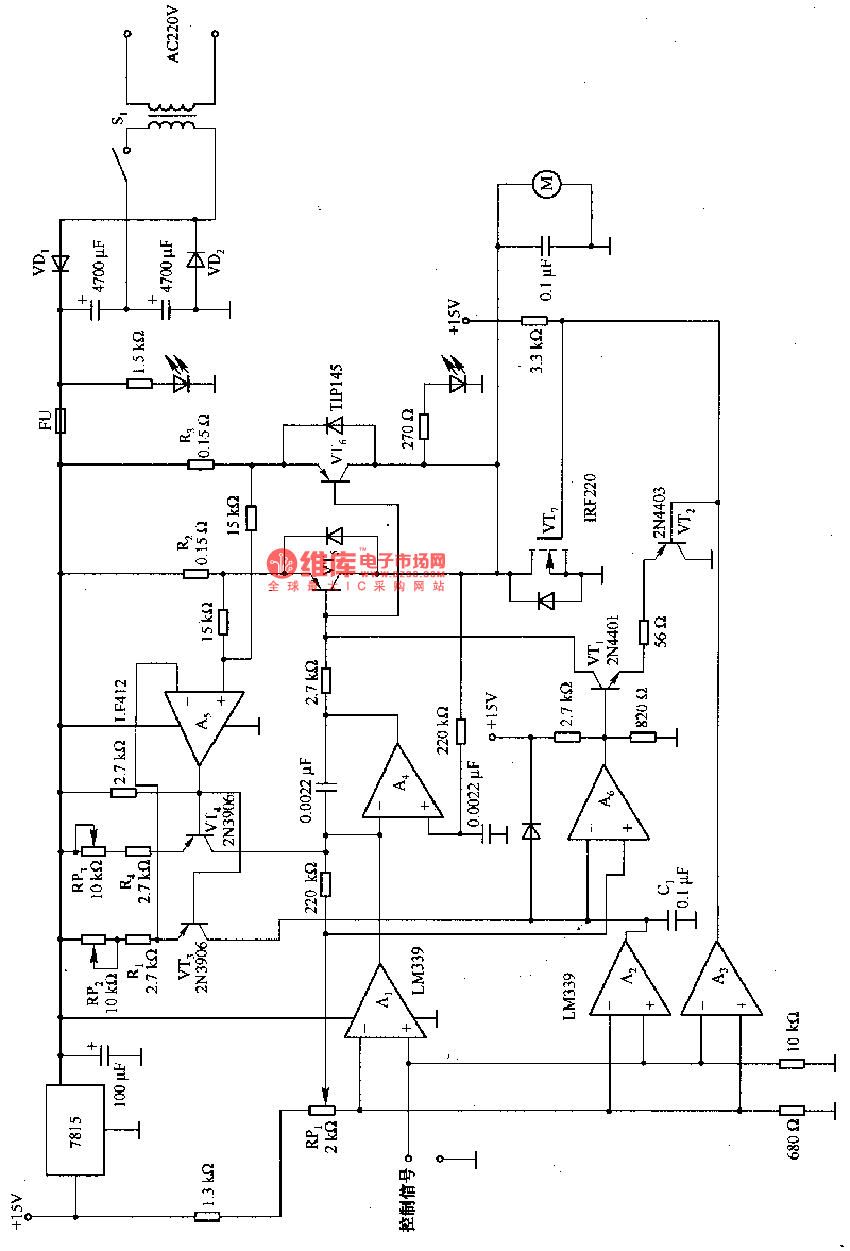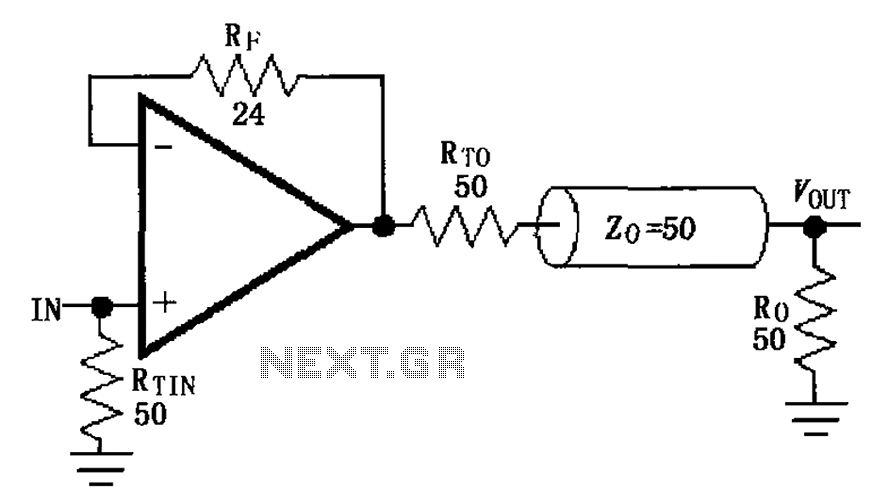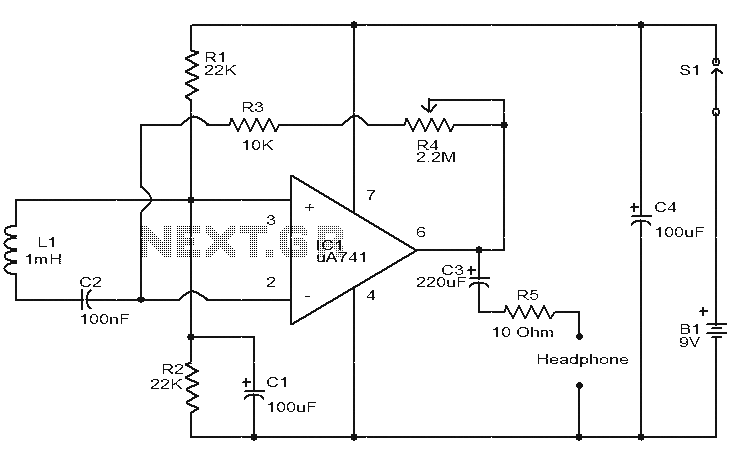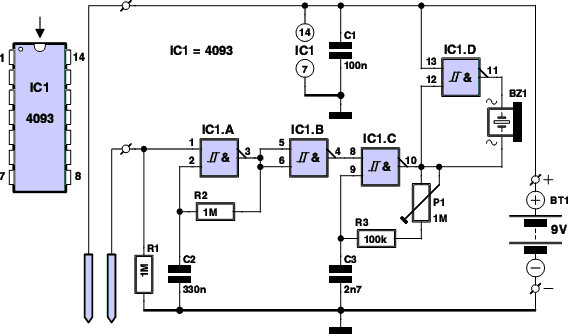
VHF Antenna Amplifier Circuit Using BFT66 Transistor

This design presents a simple antenna amplifier electronic circuit project, which can be utilized based on the provided circuit diagram. The antenna amplifier operates effectively within a frequency range of 1 to 300 MHz. It is suitable for high frequency and VHF bands (for radio and television) and offers a gain of 22 dB. The circuit features low noise performance, measuring under 1.6 dB. The VHF FM amplifier is constructed using a BFT66 transistor in a common emitter configuration. The L1 coil has a value of 6 µH, although any coil within the range of 5.6 to 6.8 µH can be employed for high frequency applications. The L2 coil is an air core type, consisting of 5 to 6 turns, with a length of 10 mm and a diameter of 5 mm. For the L2 coil, a 0.25 mm copper wire is recommended. The printed circuit board (PCB) for this circuit should be positioned close to the antenna and housed in a small metallic enclosure. The VHF antenna circuit requires a 12-volt DC power supply, which can be sourced from a 12-volt battery, as the current consumption is notably low, at under 10 mA. The T1 transistor can be substituted with other similar low noise factor transistors.
The antenna amplifier circuit is designed to enhance signal reception for various applications, particularly in VHF and FM broadcasting. The use of the BFT66 transistor ensures high gain and low noise, making it ideal for weak signal environments. The common emitter configuration of the transistor allows for significant amplification of the input signal, which is crucial for effective antenna performance.
The L1 coil, with its specified inductance, plays a vital role in tuning the circuit to the desired frequency range. The flexibility in selecting L1 allows for optimization based on specific frequency requirements while maintaining performance across the designated spectrum. The L2 coil's air core design minimizes losses associated with magnetic materials, further enhancing the circuit's efficiency.
The placement of the PCB close to the antenna is essential for minimizing signal loss and interference. The metallic enclosure not only protects the components from environmental factors but also serves to shield the circuit from electromagnetic interference, which can degrade performance.
Powering the circuit with a 12-volt DC supply ensures compatibility with commonly available batteries, facilitating portability and ease of use. The low current consumption of under 10 mA contributes to the circuit's efficiency, making it suitable for battery-operated applications.
In summary, this antenna amplifier circuit design is a practical solution for enhancing VHF and FM signal reception. Its low noise characteristics, combined with the ability to operate across a wide frequency range, make it a valuable tool for various electronic projects and applications in radio and television broadcasting.Here`s a design circuit for very simple antenna amplifier electronic circuit project can be designed using this circuit diagram. This antenna amplifier electronic circuit can be used for a frequency range between 1 and 300MHz. This circuit antenna amplifier can be used for high frequency and VHF band (for radio and TV) and will provide a 22 dB gai
n. This antenna amplifier electronic project has a very low noise, under 1. 6dB. This is the figure of the circuit. This VHF, FM amplifier circuit is constructed based on the BFT66 transistor connected in common emitter connection. L1 coil has a 6uH value, but can be used any coil for high frequency (with a value between 5. 6 to 6. 8 u H). L2 coil is an air core type coil and it has 5-6 turns (10mm long and 5 mm diameter). For L2 coil can be used a 0. 25 mm Cuem wire. The pcb of this circuit must be placed near the antenna, in a small metallic box. This VHF antenna circuit must be powered from a 12 volts DC power supply circuit, you can use a 12 volt battery, because the current consumption of this circuit is very low under 10mA.
You can replace T1 transistor with some other UIF similar transistor type which have a very low noise factor. 🔗 External reference
The antenna amplifier circuit is designed to enhance signal reception for various applications, particularly in VHF and FM broadcasting. The use of the BFT66 transistor ensures high gain and low noise, making it ideal for weak signal environments. The common emitter configuration of the transistor allows for significant amplification of the input signal, which is crucial for effective antenna performance.
The L1 coil, with its specified inductance, plays a vital role in tuning the circuit to the desired frequency range. The flexibility in selecting L1 allows for optimization based on specific frequency requirements while maintaining performance across the designated spectrum. The L2 coil's air core design minimizes losses associated with magnetic materials, further enhancing the circuit's efficiency.
The placement of the PCB close to the antenna is essential for minimizing signal loss and interference. The metallic enclosure not only protects the components from environmental factors but also serves to shield the circuit from electromagnetic interference, which can degrade performance.
Powering the circuit with a 12-volt DC supply ensures compatibility with commonly available batteries, facilitating portability and ease of use. The low current consumption of under 10 mA contributes to the circuit's efficiency, making it suitable for battery-operated applications.
In summary, this antenna amplifier circuit design is a practical solution for enhancing VHF and FM signal reception. Its low noise characteristics, combined with the ability to operate across a wide frequency range, make it a valuable tool for various electronic projects and applications in radio and television broadcasting.Here`s a design circuit for very simple antenna amplifier electronic circuit project can be designed using this circuit diagram. This antenna amplifier electronic circuit can be used for a frequency range between 1 and 300MHz. This circuit antenna amplifier can be used for high frequency and VHF band (for radio and TV) and will provide a 22 dB gai
n. This antenna amplifier electronic project has a very low noise, under 1. 6dB. This is the figure of the circuit. This VHF, FM amplifier circuit is constructed based on the BFT66 transistor connected in common emitter connection. L1 coil has a 6uH value, but can be used any coil for high frequency (with a value between 5. 6 to 6. 8 u H). L2 coil is an air core type coil and it has 5-6 turns (10mm long and 5 mm diameter). For L2 coil can be used a 0. 25 mm Cuem wire. The pcb of this circuit must be placed near the antenna, in a small metallic box. This VHF antenna circuit must be powered from a 12 volts DC power supply circuit, you can use a 12 volt battery, because the current consumption of this circuit is very low under 10mA.
You can replace T1 transistor with some other UIF similar transistor type which have a very low noise factor. 🔗 External reference





